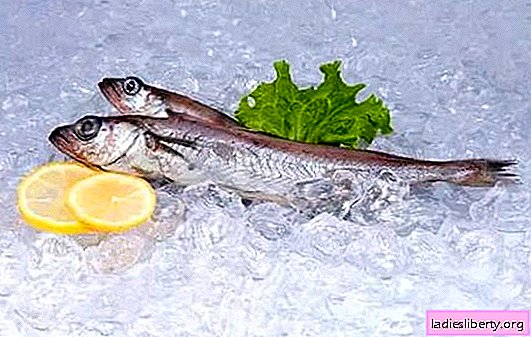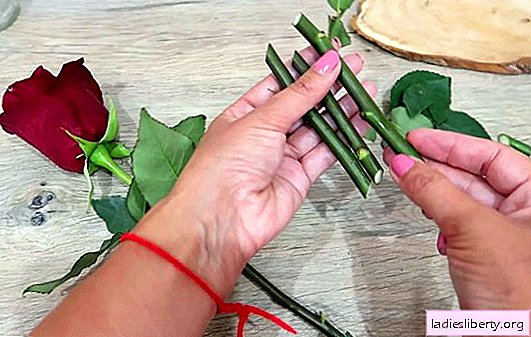
The cod family has given humankind a lot of tasty and healthy food. Among its famous representatives - saffron cod, saithe, haddock, cod, pollock - there is an inconspicuous, but very useful blue whiting.
Calorie content and chemical composition of blue whiting
The undoubted advantage of blue whiting is its ecological purity. The fact is that this species of cod is not artificially bred artificially, which means that we only eat fish that are caught in the ocean - the Atlantic or the Pacific. She grew up on natural plankton, without antibiotics and artificial dressings, which means it is completely safe for the human body. Unless, of course, that part of the ocean where the blue whiting was fed retained ecological purity.
There are two subspecies of blue whiting. They differ only in size. A resident of the northern hemisphere, who grew up in the cold ocean, is slightly smaller. But the set of nutritional properties and calorie content are the same.
A 100-gram slice of blue whiting contains a little more than 80 kcal and almost 20 grams of protein. At the same time, about one gram is fat, but there are no carbohydrates at all. This turns blue whiting into an excellent dietary product that saturates well and for a long time without overloading the body with calories. For comparison: pollock has about 70 calories, zander in 72, and about 60 in cod.
Among the nutrients that are present in blue whiting meat are the following:
• omega-3 and omega-6 fatty acids;
• retinol (vitamin A);
• thiamine (vitamin B1);
• tocopherol (vitamin E);
• riboflavin (vitamin B2);
• ascorbic acid (vitamin C);
• mineral group: phosphorus, zinc, copper, calcium, sulfur, chromium, sodium, iron, molybdenum, potassium.
The inclusion of blue whiting in the diet is beneficial for the body. The beneficial properties of this small ocean fish are important for people of any age.
The benefits of blue whiting
Blue whiting is useful primarily for those who need a diet, but good nutrition or just want to lose weight. In diseases of the stomach, the fish is not contraindicated, on the contrary, in a boiled form or chopped form, it is very desirable for the patient. The low fat content allows you to include it in the diet of people who have problems with the pancreas and liver.
The benefits of blue whiting are due primarily to the vitamin-mineral composition:
• vitamins A and E have a beneficial effect on the skin and tissues, support health, youth and beauty, strengthen vision, act as antioxidant substances, and prevent the occurrence of tumors, in particular, cancer of the intestine and breast;
• calcium preserves bone strength, prevents diseases of the musculoskeletal system, and prevents rickets in young children;
• iodine ensures the normal functioning of the thyroid gland, strengthens memory and ability to concentrate;
• omega-3 and omega-6 fatty acids are invaluable to the human body. They strengthen immunity, restore metabolic processes;
• iron improves blood composition, provides normal blood supply to internal organs, and prevents anemia.
People who regularly eat blue whiting meat are resistant to colds, bacterial and viral attacks. You can include blue whiting in the diet of people who have suffered a serious illness or operation, suffer from nervous disorders and a depressive state. Dishes from this fish help get rid of insomnia, irritability, and the effects of stressful situations.
The complex of beneficial substances contained in blue whiting meat helps to lower cholesterol. And this, in turn, is an excellent prevention of atherosclerosis, stroke, heart attack and other vascular diseases.
Among the useful properties of this fish, doctors include the following:
• it improves the functioning of the respiratory system;
• normalizes the digestive tract;
• provides optimal saturation of the body with the most important amino acids;
• relieves the condition in autoimmune diseases associated with skin defects (psoriasis, lupus);
• improves blood supply to the brain, increasing its activity;
• promotes rapid tissue regeneration.
From the point of view of the World Health Organization, a person needs to eat fish at least three times a week to maintain health. One serving should not exceed 100 grams.
Harm to blue whiting
Allergy sufferers are perhaps the only category of people who should not eat blue whiting due to intolerance to fish protein. The ailment, as a rule, becomes apparent at an early age, when the baby begins to try "adult" food. Therefore, in the process of complementary feeding, you need to carefully monitor the reaction of the child, who first tries the blue whiting. The harm may lie in a clear allergic reaction: urticaria, the development of dermatitis, shortness of breath, diarrhea, digestive upset, etc.
Extremely carefully, you should try to include fish dishes in your diet if you are allergic to seafood. In this case, a similar reaction from the gastrointestinal tract, skin and respiratory organs may develop.
To completely healthy people there will be no harm from blue whiting. It is a fish valuable in dietary and nutritional properties, helping to maintain and restore health. However, you can’t eat a lot of fish: it is not good for the gastrointestinal tract.
The fact is that the body is able to absorb a limited amount of protein, so everything that has entered the stomach in excess of the norm will simply rot in the intestine. The maximum allowable portion of blue whiting per day is no more than 200 grams.
One must also bear in mind such an unpleasant fact as infection with parasites, which in the case of blue whiting is a common phenomenon. In order not to introduce parasites into your body, it is necessary to heat the fish and cook it at high temperature for at least 20 minutes. Any cooking method is suitable: boiling, baking, frying, steaming.
After cutting the carcass, all kitchen utensils that came into contact with raw meat (boards, knives, pans, bowls) must be washed thoroughly and always rinsed with boiling water to disinfect.
Choosing a blue whiting
It is important to choose a product that will reduce the risk of infection with parasites or poisoning by low-quality fish. First of all, you need to focus on indicators such as the reliability of the seller and the cost of fish. Dangerous blue whiting caught in ecologically disadvantaged areas. Some buyers are frightened by the fact that suppliers do not need to undergo quality control according to GOST: fleet technical standards are accepted for blue whiting.
This does not mean that the product will be known to be of poor quality. However, it is better to refuse to buy too cheap fish. If possible, you can ask for documents for the goods. The responsible seller always has them.
What you need to pay attention to when buying:
• Chilled fish is not preferred. The carcass can be well inspected for spoilage and parasite infection;
• the optimum length of the carcass is 50 cm. It should have a solid, unreflected skin without spots, dents, cuts;
• in the section of the abdomen there should not be white ribbons, lumps, spiral sections;
• resilient meat that easily restores shape after pressure is a sign of freshness of the product;
• the smell of quality blue whiting should be clearly fish, without a hint of mustiness and rot;
• eyes of fresh fish are convex, transparent. Turbidity and indentation indicate spoilage of the product.
The inclusion of blue whiting in the diet is the right decision. Moreover, you can cook from this fish a lot of delicious dishes for the whole family.











